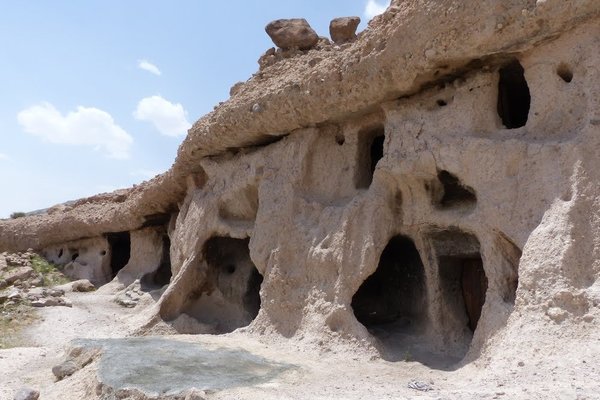Iran
Maymand
The Cultural Landscape of Maymand covers a dry desert valley in Central Iran, which is home to semi-nomadic people.
The mainly self-sufficient community practices a three-phase transhumance system, where they move between three settlements. In winter, they live in troglodytic houses carved out of soft stone rocks. The area contains houses, animal shelters, water collection points, agro-pastoral systems and rock art.
Community Perspective: This is well on the beaten path of the foreign tour group circuit, so be prepared to “be ‘invited’ to buy artefacts or the local honey!”. Alexander had a peculiar experience while staying overnight.
Site Info
Official Information
- Full Name
- The Cultural Landscape of Maymand (ID: 1423)
- Country
- Iran
- Status
-
Inscribed 2015
Site history
History of Maymand
- 2015: Inscribed
- Inscribed
- 2013: Referred
- (as Cultural Landscape of Maymand)
- 2013: Advisory Body overruled
- Deferral was advised
- Type
- Cultural
- Criteria
- iii
Links
- UNESCO
- whc.unesco.org
- Official
-
- visitiran.ir — Visit Iran
- Related
-
- atlasobscura.com — Atlas Obscura
- heritageinstitute.com — Zoroastrian Heritage
All Links
UNESCO.org
- whc.unesco.org — whc.unesco.org/
Official Website
- visitiran.ir — Visit Iran
Related Resources
- atlasobscura.com — Atlas Obscura
- heritageinstitute.com — Zoroastrian Heritage
Community Information
- Community Category
- Cultural Landscape: Continuing
Travel Information
Red Zone Travel Advisory
Recent Connections
-
Red Zone Travel Advisory
Iran fully off-limits -
Kerman Hotspot
-
Built in the 15th century
The permanent settlements developed som…
Connections of Maymand
- Geography
-
-
Desert Cultural Landscapes
Semi-desert, State Party is advised to promote the concept of Desert Cultural Landscapes
-
- Architecture
-
-
Cave dwellings
-
Vernacular architecture
cave dwellings carved out of the soft rock (kamar)
-
- World Heritage Process
-
-
Inscribed on a single criterion only
Crit iii
-
- Religion and Belief
-
-
Shia Islam
One of the caves open to visitors is a "Hosseyniyeh" - a Shia "Congregation Hall"See en.wikipedia.org
-
- Human Activity
-
-
Irrigation and drainage
In the exceptionally arid climate, traditionally every drop of water needed to be collected from a variety of sources such as rivers, springs and subterranean pools and collected in reservoirs or channelled through underground qanats to be used for animals, orchards and small vegetable plots. (Unesco) -
Pastoralism
-
Transhumance
"...reflects a traditional three phase transhumance system with unusual troglodytic winter housing in a dry desert environment" (AB) -
Pictographs
Karaftū Cave: "One of the important attractions of the site is the pictographs (showing human, animal and plant designs)." (nom file)
-
- WHS on Other Lists
-
-
Melina Mercouri Prize
the historic village of Maymand (winner 2005)
-
- Timeline
-
-
Built in the 15th century
The permanent settlements developed sometime before the 16th century (AB ev)
-
- WHS Hotspots
- Visiting conditions
-
-
Red Zone Travel Advisory
Iran fully off-limits
-
News
No news.
Community Reviews
Show full reviews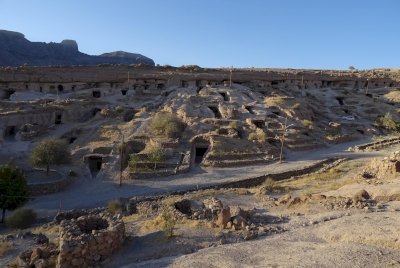
I'm surprised by the ratings and the statements of the community concerning this WHS. I understand the bad experience of Alexander, it could happen elsewhere. I agree with Zoe, troglodyte houses are not so uncommon.
The steep-sided village of Meymand, above all when the sunset is coming, is a very pleasant place. I passed a nice night in a troglodyte room without any problem (maybe i'm lucky?), and frankly speaking it was a good experience and a good souvenir.
I wonder now if I am not too easy to please, yet I have had other experiences less memorable...
Keep reading 0 comments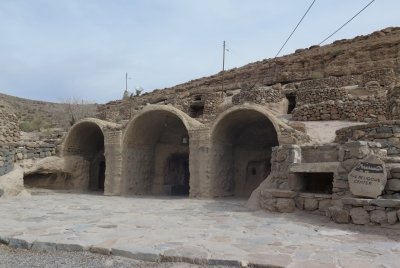
I unfortunately have to rate this a bit low even though it is kind of interesting. I don't think living in cave houses is that special though, I saw it in Shaanxi the first time albeit a bit different style, but there goes my “oh wow these guys are old school rock house people, that's hardcore!” that should have been evoked on arrival. Dwayne Johnson doesn't even live here, what a bummer!
I wasn't the only tourist but I got the usual taroof and he waved me through as I got all over Iran. The Iranians driving right inside were charged promptly. I gave the nice old man the 30,000 riyal on my way out anyway, sitting out there in the cold all winter plus it goes to some benefit of village upkeep rather than his smoking habit, right?!
You see most buildings right near the start, the school, the old bath, the houses of course, then when you get to the center of the village you find the fire temple. Venturing further is not necessary but also not very far. Many houses were closed as in winter the inhabitants migrate to a warmer place. This also meant the fire temple was closed unfortunately.
As I said before, the idea of having your house carved out of a cave doesn't do it for me, especially when you see the power lines all over the place. The inhabitants clearly have a “real” house inside with basic kitchen and …
Keep reading 0 comments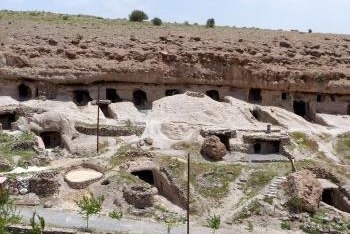
Our visit to Maymand was certainly less traumatic than that of the previous reviewer! It was interesting and pleasant enough but, on reflection, we didn’t perhaps really get to see enough of what gives the site its OUV. OK – we saw the troglodyte dwellings but the “Cultural Landscape” inscription covered rather more than these.
We reached the village after a 2.5hr drive from Kerman. N.b It seems best approached from the south via Shah-e Babak even though maps might suggest reaching it from the North by turning off highway 84 at Ahmadabad. A small group of foreign tourists was already there - the Kerman to Yazd journey is a major stage on the “Central Iran” tour circuit and, in all honesty, there isn’t a great deal else to see along it so, I suspect that Maymand is quite well positioned to benefit as a stop over, not too far off the direct route. As noted by the previous reviewer, the village already seems to have been well set up to receive tourists, with bilingual signs and explanatory notices outside the main points of interest, plus a number of UNESCO signs and also a plaque for the “International Melina Mercouri Prize for the Safeguarding and Management of Cultural Landscapes” – awarded as long ago as 2005 by “UNESCO - Greece” and 10 years before the village gained inscription. See - http://whc.unesco.org/en/activities/511. Apparently it brought with it a prize of US $20k which presumably provided some “seed corn” to develop …
Keep reading 0 comments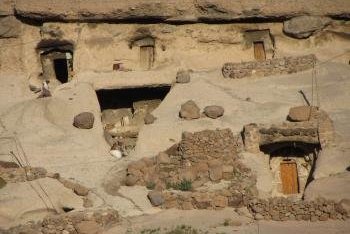
My visit to Maymand was a bizarre experience that is unlikely to be replicated by others, so my review should not be taken to be especially representative of the typical experience. I arrived via chartered taxi around 5:30pm, because the driver assured me it would only be 1.5 hours drive from Kerman and thus refused to leave earlier. This was very obviously wrong, and it took closer to 3.5. This wasn’t catastrophic, given sunset wasn’t until after 7:30, so there was still plenty of time to look around.
The entrance to the village is rife with triumphant UNESCO decoration and English-language touristy signage, as it has evidently become a part of the tour group circuit during the day. When I arrived, however, all the doors to all the cave-houses were closed, and the village was essentially deserted apart from a confused-seeming old man who very insistently tried to give me a bundle of blank CDs. This set the tone of my experience.
Eventually an old woman was found, though she seemed annoyed by my presence. I thought accommodation had been organised in advance by my hotel in Kerman, but this did not seem to hold much sway. A room was procured, notably not anywhere near the heavily signed Guesthouse on the other side of the small river. The ‘bed’ was a slab of plywood.
Wandering through the village itself around sunset was rather pretty, and it was nice to see some friendly dogs around for once (Iran seems to almost …
Keep reading 0 comments
